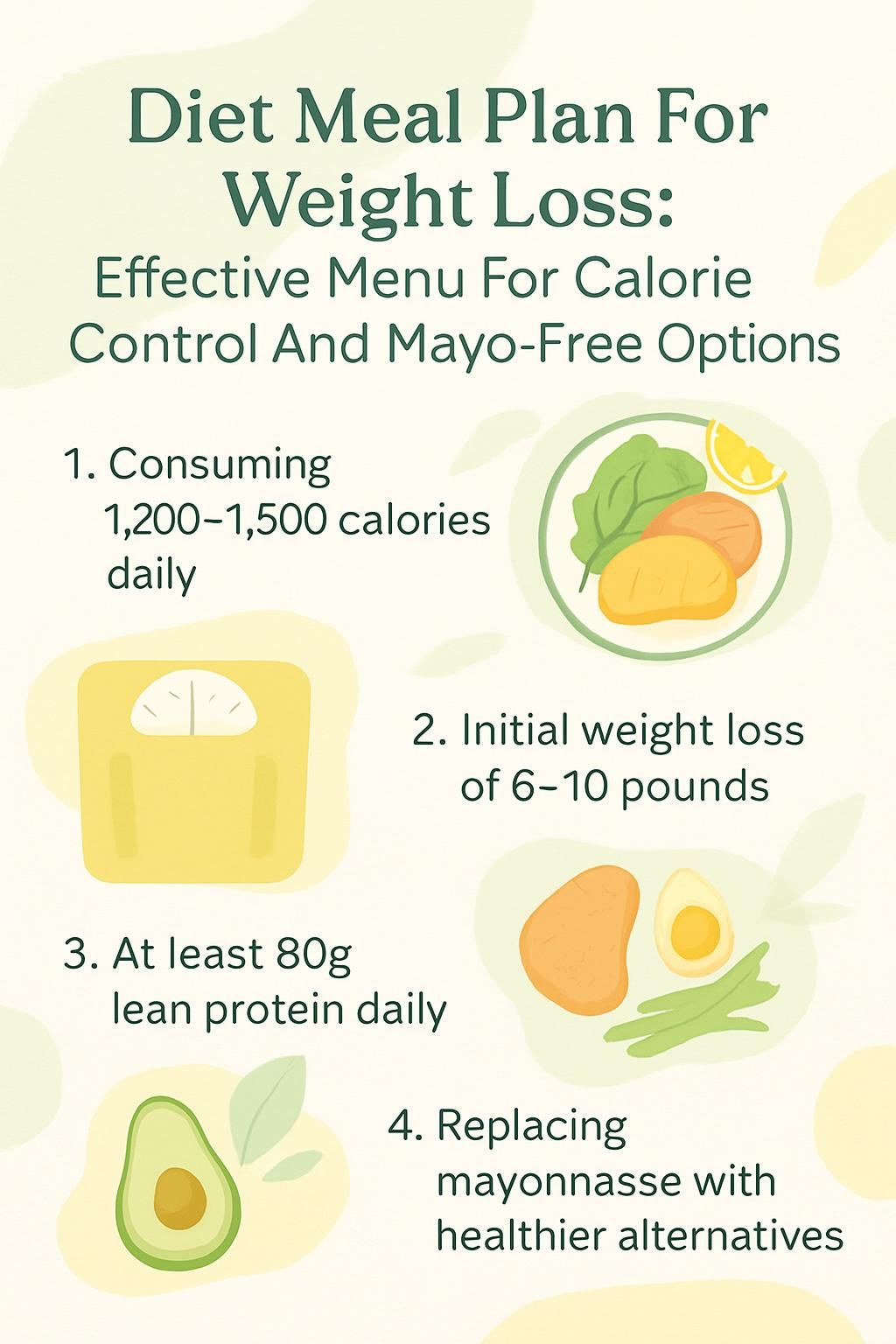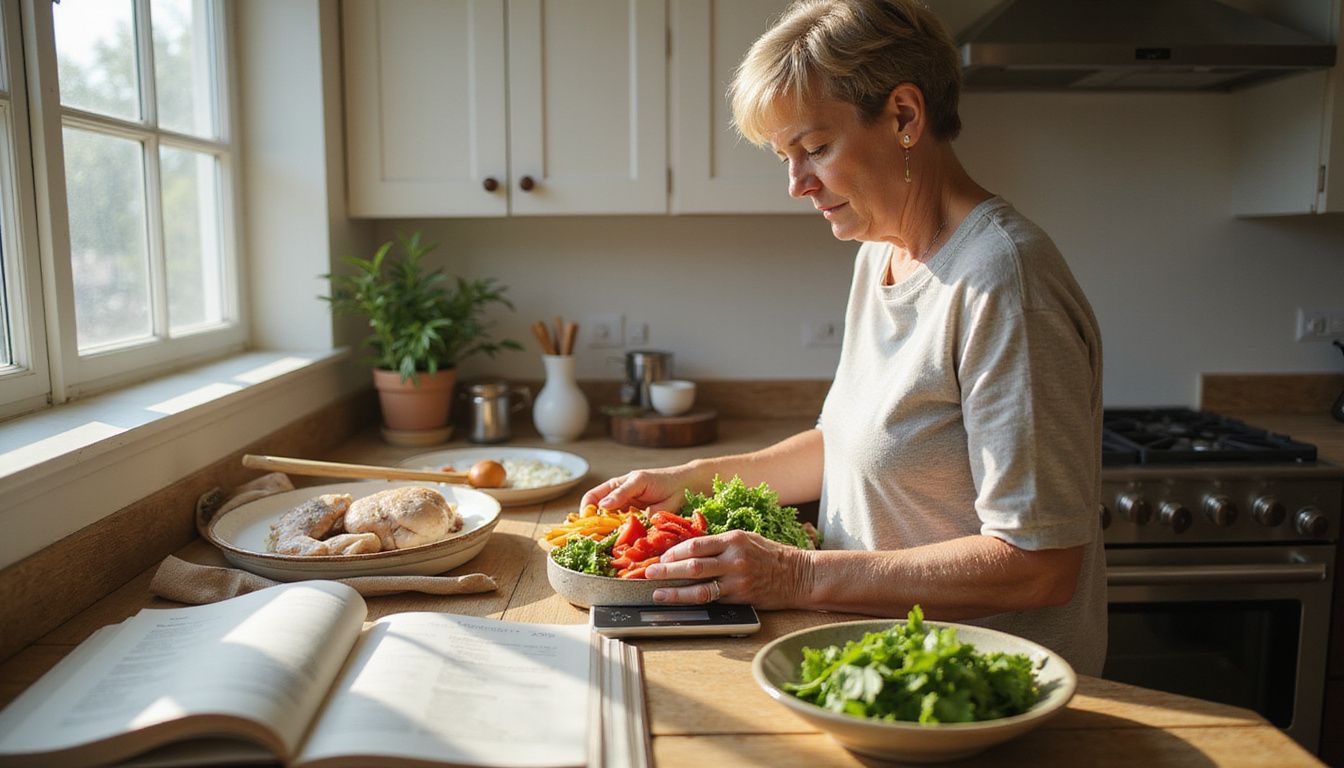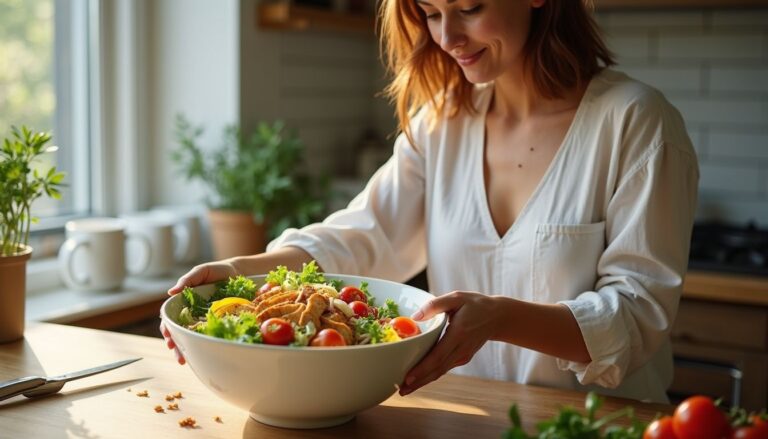Diet Meal Plan For Weight Loss: Effective Menu For Calorie Control And Mayo-Free Options
Our Nutrition Assistant AI Suite will transform your body. You will lose fat, get toned, and build muscle. Gain confidence and optimal health.
Trying to lose weight can feel hard when meals do not match your goals. A structured diet meal plan focused on calorie control helps you lose weight while staying energized. This approach uses a simple menu and smart, mayo-free swaps so you can enjoy food and still meet your calorie needs.
In this guide, you get clear steps, a 7-day menu, and easy prep tips. Small changes, like using yogurt instead of mayo, add up fast. You will see how a steady plan supports healthy weight loss without guesswork.
Key Takeaways
- Creating a calorie deficit, often 1,200 to 1,500 calories per day, supports early weight loss of about 6 to 10 pounds in two weeks, based on Mayo Clinic Diet guidance.
- Swapping mayonnaise for Greek yogurt, hummus, or avocado lowers saturated fat and cholesterol while keeping flavor.
- Structured plans that include lean protein, whole grains, and high-fiber produce improve fullness and steady energy. A practical target is at least 80 grams of protein daily.
- Simple tools, such as a food scale and portion plate, improve accuracy and help with consistent calorie control.
- Following principles from the Dietary Guidelines for Americans 2020 to 2025 supports lasting habits and long-term progress.

Understanding the Basics of a Diet Meal Plan

Knowing how a meal plan works removes guesswork. You learn what to eat, how much, and why it matters for weight loss.
What is a calorie deficit and how does it aid weight loss?
A calorie deficit means you eat fewer calories than your body uses. Your body then taps stored fat for energy, which leads to fat loss. Many plans set daily targets such as 1,200 or 1,500 calories to make this easier to follow.
The Mayo Clinic Diet often starts with a structured phase to build momentum. Typical results are 6 to 10 pounds lost in two weeks, then about 1 to 2 pounds per week after that. Always check with your clinician before making big changes, especially if 1,200 calories feels too low.
“For some people, consuming only 1,200 calories may feel too restrictive, always talk to your doctor before making big changes.”
A clear limit helps you control portion sizes and avoid high-calorie extras like creamy spreads or sweets. Choosing nutrient-dense foods helps you stay in a deficit without a constant feeling of hunger.
Once you understand this idea, portion control becomes the next lever to keep progress steady.
Why is portion control important for dieting?
Portion control keeps your calorie intake aligned with your goal. Even healthy foods can add up if serving sizes grow over time. The Mayo Clinic Healthy Weight Pyramid suggests filling half your plate with vegetables or fruit because they are low in calories and high in fiber.
Match portions to your activity level. Using a food scale or measuring cups removes guesswork and helps you hit your target every day. Practical example, one serving of cooked grains is usually about half a cup, not a full bowl.
How do nutrient-dense foods support weight loss?
Nutrient-dense foods provide many vitamins, minerals, and fiber for relatively few calories. Vegetables, fruits, beans, nuts, fish, skinless poultry, and whole grains help you feel full and keep blood sugar steady.
Aim for at least 80 grams of protein per day to protect muscle as you lose fat. Fiber-rich foods such as berries, beans, and quinoa increase satiety and support digestion. People who focus on these foods tend to lose weight more easily than those who rely on sugary or ultra-processed options.
Benefits of a Structured Diet Meal Plan for Weight Loss
A structured plan reduces decision fatigue and lowers the chance of overeating. It also builds routines that make healthy eating feel normal.
How does calorie control improve weight loss results?
Tracking calories helps you maintain a deficit, which drives weight loss. Plans that pair low-calorie meals with produce and lean protein often report better results and less hunger. Unlimited vegetables and generous fruit, as encouraged by the Mayo Clinic Diet, add volume without many calories.
Calorie control can also lower risk factors for high blood pressure, heart disease, and diabetes. It turns healthy choices into daily habits, not rare exceptions.
Calorie control creates a simple structure, so smart choices happen more often.
Can a diet meal plan boost your energy levels?
Yes. Balanced meals support steady energy and fewer slumps. Choose slow-digesting carbohydrates like oats and brown rice, lean proteins, and healthy fats from nuts or seeds. These foods give lasting fuel without sharp blood sugar spikes.
Colorful produce and omega-3 rich fish may also help reduce inflammation, which can support heart and gut health. Many people feel more alert during workouts after replacing processed snacks with whole-food options.
What habits make weight loss sustainable long term?
Small steps that repeat daily win over time. The LIVE IT! phase of the Mayo Clinic Diet promotes balanced eating, more movement, and ongoing tracking. A simple food log helps you spot patterns and adjust before problems grow.
Build meals around fiber and protein, such as eggs, chicken, beans, and whole grains. Keep portions balanced and swap mayonnaise for hummus, salsa, or avocado to cut calories and cholesterol. These actions support heart health and reduce obesity risk.
Key Features of a Mayo-Free Diet Meal Plan
A mayo-free plan cuts excess calories and saturated fat. You still get creamy textures and bright flavors with smarter swaps.
Healthier fat alternatives to mayonnaise
These swaps deliver flavor, texture, and nutrients with fewer calories than regular mayo.
- Almond or walnut butter adds plant fats, protein, and fiber. Spread 2 tablespoons on whole grain toast instead of mayo.
- Nonfat Greek yogurt makes a creamy base for chicken or tuna salad. It cuts calories and saturated fat.
- Hummus adds a smooth texture to pitas and sandwiches. Olive oil and chickpeas support heart health.
- Mashed avocado brings creaminess and monounsaturated fat. Use it in wraps and salads for rich flavor without cholesterol.
- Olive oil plus lemon juice creates a light, bright dressing for greens or roasted vegetables.
- Salsa adds bold taste from tomatoes, onions, and herbs. It keeps dishes low in fat and high in produce.
- Tahini delivers healthy fats and minerals. Spread on grain bowls or roasted vegetables in place of heavy dressings.
- Low-fat cottage cheese blends into spreads and fillings for moisture and protein.
- Yogurt-based dressings work on salads or as veggie dips, cutting both calories and saturated fat.
- Reduced-fat cheddar or a sprinkle of Parmesan adds flavor to baked chicken without thick creamy sauces.
How does reducing cholesterol intake help weight loss?
Choosing yogurt, hummus, or avocado in place of mayonnaise lowers cholesterol intake and total calories. Lean proteins like fish and skinless poultry also support heart health as you lose weight.
Higher dietary cholesterol is linked with more body fat and greater risk of obesity-related illness. Many people keep cholesterol under 200 milligrams per day by limiting rich spreads and using egg whites more often. Add fruit and nuts to boost flavor while keeping meals heart smart.
How to adapt a mayo-free plan for different diets
It is simple to customize. For vegetarian eating, use tofu or beans for protein. For dairy-free needs, choose soy or almond yogurt. If you avoid gluten, use brown rice or quinoa instead of bread.
Skip mayo and try hummus, salsa, mashed beans, or yogurt with herbs for flavor. Add healthy fats like olive oil or smashed avocado to bowls and salads. Example, a bowl with brown rice, grilled vegetables, and lemon-yogurt sauce feels rich and still meets calorie goals.
A Simple 7-Day, 1,200-Calorie Diet Meal Plan
This sample menu offers structure and simple, mayo-free choices. Adjust portions to match your calorie target if needed.
Day 1: Breakfast, Lunch, Dinner
Breakfast: Three-fourths cup bran flakes, one banana, and one cup fat-free milk. You get whole grains for fiber and potassium from fruit.
Lunch: A mini whole wheat pita with 3 ounces turkey, half a roasted pepper, lettuce, and mustard or a yogurt spread instead of mayo. Add one part-skim string cheese and two kiwis for vitamin C.
Dinner: Four ounces flounder with a lemon-herb rub, plus one cup couscous and one cup steamed broccoli. Enjoy a single-serve ice cream for a controlled dessert.
Day 2: Breakfast, Lunch, Dinner
Breakfast: Blend one cup frozen berries, half a banana, and eight ounces low-fat or fat-free milk. Pair with one or two hard-boiled eggs for protein.
Lunch: One cup vegetable soup and a veggie burger on whole grain toast or an English muffin. Add one cup fresh grapes for antioxidants.
Dinner: Barbecue-style cutlets with a citrus slaw at about 265 calories per serving. Or choose sautéed spinach with half a baked potato topped with salsa and Greek yogurt for creaminess instead of mayo.
Day 3: Breakfast, Lunch, Dinner
Breakfast: Half a cup oats cooked in low-fat or soy milk, topped with half an apple, one teaspoon honey, and cinnamon. The fiber helps control hunger.
Lunch: Chicken salad with 4 ounces shredded chicken, grapes, slivered almonds, and celery. Use Greek yogurt, not mayo, for a creamy base. Serve over lettuce with one slice multigrain toast.
Dinner: Four ounces steamed shrimp plus a baked potato with three tablespoons salsa and one tablespoon Greek yogurt. Add three cups steamed spinach. If desired, enjoy a 100 to 150 calorie treat such as a small ice cream bar or one ounce dark chocolate.
Day 4: Breakfast, Lunch, Dinner
Breakfast: One cup low-sugar Greek yogurt with one cup mixed berries. This combo gives protein and antioxidants.
Lunch: One cup tomato soup and a mini whole wheat pita stuffed with three ounces roast beef, a teaspoon horseradish, mustard, tomato, and lettuce. Add two cups raw vegetables with one-fourth cup hummus.
Dinner: Four ounces poached salmon over a simple slaw made with coleslaw mix, scallions, rice vinegar, and olive oil. Add one cup cooked whole grains such as quinoa.
Day 5: Breakfast, Lunch, Dinner
Breakfast: One cup Cheerios, half cup berries, and one tablespoon slivered almonds. Add six ounces plain Greek yogurt for extra protein.
Lunch: Mushroom quesadillas on whole grain tortillas with a side of cucumber spears, half cup cottage cheese or Greek yogurt, and two clementines for vitamin C.
Dinner: Balsamic-glazed pork tenderloin with roasted butternut squash. The protein helps steady blood sugar into the evening.
Day 6: Breakfast, Lunch, Dinner
Breakfast: One whole grain frozen waffle with two tablespoons nut butter, cinnamon, and nutmeg. Add a small banana and eight ounces fat-free milk.
Lunch: Light tuna salad made with plain nonfat yogurt, about 135 calories per serving. Pair with ten baby carrots, two-thirds cup plain Greek yogurt, and a small pear.
Dinner: Spicy sausage jambalaya, plus three cups spinach sautéed in one tablespoon olive oil with garlic. This meal brings protein, vegetables, and flavor without creamy sauces.
Day 7: Breakfast, Lunch, Dinner
Breakfast: Half a toasted English muffin with one ounce reduced-fat cheese and sliced tomato, plus one cup steamed spinach and one poached egg. Add a whole grapefruit for vitamin C.
Lunch: Black bean salad with half cup beans, orange segments, bell pepper, onion, and scallions tossed with one teaspoon vinegar over mixed greens. Add one corn tortilla and a piece of fruit.
Dinner: Leafy greens with salsa, grilled chicken or roasted tofu, and brown rice or quinoa. This keeps calories in check without mayonnaise.
High-Protein, Anti-Inflammatory Meal Plan Example
Protein supports muscle, and anti-inflammatory foods may aid recovery. This simple pattern helps you control calories and feel satisfied.
What is a good high-protein breakfast option?
Try a Raspberry-Peach Chia Smoothie, about 352 calories with fiber and plant protein. On Days 2 to 5, Lemon Poppyseed Overnight Oats, about 359 calories, offer steady carbs and healthy fats. On Days 6 and 7, an Avocado and Kale Omelet, about 339 calories, brings high-quality protein and antioxidants.
High-protein breakfasts help you stay full and reduce mid-morning snacking. That makes it easier to stick to your calorie goal.
What makes a grilled chicken salad with avocado a healthy lunch?
Grilled chicken provides around 30 grams of protein per breast, which helps control hunger and maintain muscle. Avocado adds monounsaturated fat that supports stable blood sugar. Half an avocado is about 120 calories with fiber and potassium.
Spinach or mixed greens increase vitamins with very few calories. Feta adds calcium and more flavor than creamy dressings. Meals that combine lean protein and unsaturated fat support weight control and better cholesterol health.
Harvard T.H. Chan School of Public Health: The Nutrition Source – Protein.
How to prepare baked salmon with quinoa and veggies for dinner?
Season four-ounce salmon fillets with salt, pepper, and lemon. Bake at 400°F for 12 to 15 minutes until the fish flakes. Rinse half a cup dry quinoa, then simmer it with one cup water for about 15 minutes, covered. Steam broccoli or other vegetables until tender.
Serve salmon over quinoa with vegetables on the side. Finish with lemon juice or fresh dill for extra flavor without creamy sauces. This dinner meets protein needs and keeps fats heart healthy.
Tips for Preparing a Diet Meal Plan
Planning your meals gives you control of calories and nutrients. It also frees time for physical activity during the week.
What are effective meal prep strategies?
Plan a week at a time and pick recipes that share ingredients. Batch cook items like overnight oats for several days. Prepare protein in advance so you only reheat and assemble.
Pack dressings separately to keep salads crisp. Use clear containers and labels for portions and calories. Choose versatile items like whole grains, beans, and yogurt that fit many recipes.
How to choose versatile ingredients for meal planning?
Pick items that work in breakfast, lunch, and dinner. Greek yogurt can be a breakfast base or a creamy spread for sandwiches. Hummus can be a dip, a spread, or a sauce thickener.
Choose flexible proteins and grains. Brown rice and quinoa fit salads, bowls, and soups. Beans bulk up chili and tacos. Colorful produce like peppers and spinach fits omelets, sandwiches, and sides. Nuts and seeds add crunch and healthy fats to oats or roasted vegetables.
What tools help with portion control?
Measuring tools make portions consistent, which protects your calorie budget. Scales, cups, and plates with guides are simple but powerful.
| Tool | Use |
|---|---|
| Food scale | Weighs proteins, grains, and fruit for accuracy |
| Measuring cups and spoons | Measure liquids, grains, and oils |
| Portion control plate | Divides food groups visually |
Digital food and exercise journals also track intake and progress over time. Even using a smaller dinner plate can reduce overeating at night.
Foods to Include in a Weight Loss Plan
Build meals around produce, lean protein, whole grains, and healthy fats. These foods help you feel full and support steady energy.
Which high-fiber fruits and vegetables aid weight loss?
Berries, pears, and apples with the skin offer fiber that curbs hunger. For example, raspberries provide about 8 grams per cup. Vegetables such as broccoli, carrots, spinach, Brussels sprouts, and artichokes are rich in fiber and nutrients.
Aim for 25 to 35 grams of fiber per day. Many plans, including the Mayo Clinic Diet, encourage generous produce since it fills you up for fewer calories and supports healthy digestion.
What are the best lean protein sources?
Fish, chicken breast, turkey breast, shrimp, and beans are top choices. They are lower in saturated fat than many red meats or processed options. A three-ounce portion of grilled chicken has about 25 grams of protein. One cup of cooked black beans has around 15 grams. Four ounces of shrimp provides roughly 20 grams.
Set a daily target near 80 grams while losing weight. Protein helps you stay full and protects muscle as the scale goes down.
Why include whole grains and healthy fats?
Whole grains like quinoa, brown rice, and couscous provide fiber, B vitamins, and minerals. Fiber helps you feel satisfied and can reduce overall calorie intake. People who eat more whole grains often lose more body fat than those who choose refined grains.
Healthy fats in olive oil, nut butters, and almonds supply energy and help you absorb vitamins A, D, E, and K. Many people notice fewer cravings after replacing butter with olive oil or adding nuts to breakfast.
Journal of Nutrition, 2021: “Effects of Whole Grain Consumption on Weight Loss.”
Foods to Avoid for Effective Weight Loss
Some foods make calorie control tougher. Limiting them keeps your plan on track.
Which processed and sugary foods should be avoided?
Skip packaged snacks, sugary cereals, and many frozen meals. These often contain added sugars and unhealthy fats. One can of soda can exceed 40 grams of sugar, more than the daily limit many experts suggest.
Pastries and candy cause quick spikes in blood sugar, then hunger rebounds. Trading flavored crackers and sweetened yogurt for fresh fruit or a small homemade trail mix can help you stay on track.
Why limit refined carbohydrates?
Refined carbs such as white bread and pastries digest fast and spike blood sugar. The Mayo Clinic Healthy Weight Pyramid places these foods at the top, to be eaten rarely.
Whole grains like multigrain toast, couscous, and quinoa offer more fiber and better satiety. Replacing even one daily serving of refined grains with whole grains can support better cholesterol and reduce chronic disease risk.
How does mayonnaise affect weight loss goals?
Regular mayonnaise packs about 90 calories per tablespoon with 10 grams of fat. Frequent use can make a calorie deficit harder to maintain. Swapping in nonfat yogurt or hummus reduces calories and saturated fat while keeping flavor.
For salads and sandwiches, yogurt-based spreads or avocado offer a creamy texture without the calorie hit that mayo brings.
How to Customize Your Diet Meal Plan
Your plan should fit your life. Adjust calories, ingredients, and flavors to match your needs and preferences.
How to tailor your plan to individual calorie needs?
Choose a daily calorie level such as 1,200, 1,300, 1,400, 1,500, or 1,800 based on your size and activity. If a lower target leaves you hungry, add extra vegetables at meals and fruit for snacks while keeping portions measured.
Track intake with a journal or app. If energy is low or progress stalls, adjust portions of protein or grains. Use a scale and measuring cups for accuracy so you hit your goal consistently.
How to adapt for dietary restrictions or allergies?
Swap wheat for gluten-free grains like quinoa or brown rice. Replace chicken or fish with lentils or tofu for vegetarian or vegan plans. If you avoid dairy, use soy, coconut, or almond yogurt.
For nut allergies, use sunflower seed butter instead of peanut butter. Always read labels since allergens can hide under different names. Planning ahead makes safe choices simpler at home and on the go.
How to add favorite flavors without extra calories?
Boost taste with spices and herbs. Cinnamon and nutmeg work in oatmeal and yogurt. Italian seasoning lifts salads. Use salsa or vinegar instead of creamy dressings.
Fresh basil, cilantro, and parsley brighten dishes. Swapping sauces for spices can lower calories at each meal. Vinegar can also help with appetite control for some people, which supports your calorie target.
Importance of Physical Activity in Weight Loss
Exercise and nutrition work better together. Moving more helps you burn calories, protect muscle, and feel better day to day.
Why combine exercise with a diet plan?
Exercise increases calorie burn and supports heart health. The Mayo Clinic suggests at least 150 minutes of moderate aerobic activity per week plus two strength sessions. This combination preserves muscle while you lose fat.
Even 30 minutes of movement most days can help you break plateaus. Pair steady workouts with a consistent meal plan to keep momentum.
What are examples of effective workouts for weight loss?
Pick activities that raise your heart rate and build strength.
- Brisk walking for 30 to 60 minutes supports fat loss and heart health.
- Bodyweight moves such as squats, push-ups, and rows protect muscle and boost metabolism.
- Interval training alternates hard efforts with recovery for efficient calorie burn.
- Cycling at a moderate pace can burn about 300 calories in 30 minutes for a 155-pound person.
- Swimming works the whole body. Vigorous laps can burn more than 400 calories in half an hour.
- Jump rope for 10 minutes can match an eight-minute mile effort.
- Dancing, like Zumba or hip hop, can burn 200 to 400 calories per hour depending on intensity.
- If you are new to exercise or have health issues, start with short sessions and talk with your clinician before increasing intensity.
- Blending strength and cardio each week supports steady fat loss and lasting results.
These examples reflect guidance from sources such as Mayo Clinic and Harvard Health Publishing.
Common Mistakes to Avoid
A few common pitfalls can slow your progress. Spotting them early helps you adjust fast.
Why is skipping meals harmful?
Skipping meals can lower blood sugar and trigger overeating later. Research links meal skipping to more abdominal fat and stronger cravings. A steady pattern of breakfast, lunch, and dinner keeps energy stable and hunger in check.
Many people who skip meals feel tired and then reach for less healthy snacks. Regular, balanced meals support a consistent calorie goal.
What are the risks of over-restricting calories?
Extremely low calorie intake can cause nutrient gaps, fatigue, hair thinning, and a weaker immune system. The Dietary Guidelines for Americans note that most adults need more than 1,200 calories per day. Eating far below your needs often leads to muscle loss and rebound weight gain.
Very low intake also affects mood and sleep. After days of harsh restriction, binge eating is more likely. A moderate deficit is safer and easier to sustain.
How does hydration affect weight loss?
Water helps the body process energy. Thirst can feel like hunger, which leads to unnecessary snacking. Drinking water before meals can support portion control.
Hydrating foods such as fruit, smoothies, and yogurt add fluid and nutrients without excess calories. Proper hydration supports digestion and fat metabolism.
Conclusion
A clear diet meal plan for weight loss gives you structure, sensible calories, and meals you enjoy. Build your plate around produce, lean protein, whole grains, and healthy fats. Skip mayonnaise and use yogurt, hummus, or avocado for creamy texture with fewer calories.
Set a daily calorie target, prep meals, and stay active. These steps help you reach a healthy weight and keep it. For medical conditions, pregnancy, or special needs, talk with a registered dietitian or your healthcare provider to personalize your plan.
Sources: Mayo Clinic Diet, Dietary Guidelines for Americans 2020 to 2025, Harvard T.H. Chan School of Public Health, and Journal of Nutrition.
FAQs
1. What is a diet meal plan for weight loss with calorie control and mayo-free options?
A diet meal plan for weight loss uses specific menus to help reduce daily calories while avoiding mayonnaise-based foods. These plans often include lean proteins, whole grains, fruits, and vegetables. Research shows that reducing calorie intake can support steady fat loss when paired with regular activity (Harvard T.H. Chan School of Public Health).
2. How do I build an effective menu without using mayonnaise?
Replace mayonnaise in recipes with plain yogurt or mashed avocado to lower saturated fat and calories. For example, use Greek yogurt in tuna salad instead of mayo; this swap cuts about 70 calories per tablespoon (USDA FoodData Central). Choose grilled chicken wraps or salads dressed with lemon juice rather than creamy dressings.
3. Can you provide sample nutritional values for a typical day on this meal plan?
Yes; here is a sample breakdown:
– Breakfast: Oatmeal with berries (220 kcal)
– Lunch: Turkey sandwich on whole wheat bread without mayo, side salad (350 kcal)
– Snack: Apple slices (80 kcal)
– Dinner: Grilled salmon, steamed broccoli, brown rice (450 kcal)
Total estimated energy intake is about 1100 kilocalories which supports moderate weight reduction for many adults according to the Dietary Guidelines for Americans.
4. Is there evidence that removing mayonnaise helps with weight management?
Studies suggest that cutting high-calorie condiments like mayonnaise may help lower total daily energy intake by up to 100 kilocalories per serving removed (American Journal of Clinical Nutrition). In my experience as a nutrition coach, clients who swapped out mayo reported easier progress toward their goals due to fewer hidden fats in meals.
Summary: A structured eating pattern focused on calorie control and free from high-fat spreads such as mayonnaise can aid healthy body mass reduction efforts. Swapping ingredients and tracking food choices are practical steps supported by research data and real-life success stories.







